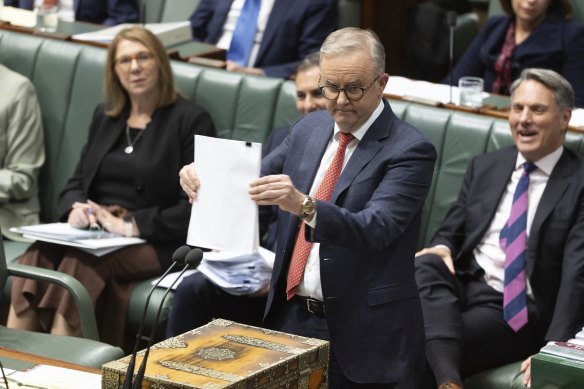By Mike Foley and Nick Toscano
Australia must move faster to build large-scale renewable projects or risk blackouts and soaring energy prices when coal-fired power stations close down, the electricity grid operator has warned.
In its 25-year blueprint for the nation’s grid, the Australian Energy Market Operator (AEMO) warned that not enough renewable energy generators, batteries and transmission lines are being built in time to replace the shortfall as coal-fired power stations close down.

Prime Minister Anthony Albanese on Tuesday.Credit: Alex Ellinghausen
“This risk must be avoided,” chief executive Daniel Westerman said.
“This [plan] is a clear call to investors, industry and governments for the urgent delivery of generation, storage and transmission to ensure Australian consumers continue to have access to reliable electricity at the lowest cost.”
Ten large coal-fired power stations have closed since 2012 and AEMO now expects 90 per cent of remaining coal capacity to close by 2035. Coal is likely to have left the grid entirely by 2040, it adds, as ageing plants become less reliable and less competitive against cheaper renewable energy.
AEMO, which oversees the transition of Australia’s interstate electricity and gas markets, outlined an “optimal development pathway”, which is the lowest-cost energy grid, dominated by renewables, that would cost $122 billion out to 2050.
The timeframe for closure of coal-fired power stations is being accelerated by competition from cheaper renewables, which are at times supplying zero-cost electricity to the grid.
But the operator warned that significant new investment is needed to replace the power currently supplied by coal – about one-third of the grid’s current generation capacity – when it is no longer in use.
It said new wind and solar farms sufficient to generate 134 gigawatts of power are needed, more than double existing capacity.
The grid will also need 86 gigawatts more of rooftop solar, which has a current capacity of 18 gigawatts, as well as 75 gigawatts more dispatchable energy from projects such as pumped hydro, batteries and gas plants.
The Albanese government’s existing plan to double the share of renewables in the grid to 82 per cent by 2030 is running well behind schedule, putting Australia at a heightened risk of blackouts and volatile prices during the transition.
Since the 2022 election, the federal government has approved projects that would deliver 8.4 gigawatts of power, which Environment Minister Tanya Plibersek says is double the rate of approvals by the former Morrison government – but only a fraction of the total requirement.
Wind farm approvals are also a problem, with just two approved in the past 17 months. Regional communities around the country have mounted anti-renewables campaigns and AEMO said the government must work harder to win the support of communities.
Energy Minister Chris Bowen said: “AEMO tested 1000 scenarios to identify the lowest-cost plan that would also meet our growing electricity needs and keep the grid reliable between now and 2050.”
Opposition Leader Peter Dutton has criticised the government’s renewables-heavy plan as undeliverable and promised a future Coalition government would build seven nuclear plants across the country, with the first coming online before 2037, to supplement renewables.
The AEMO plan does not assess the costs of nuclear energy because nuclear energy is currently banned under federal law.
But it said nuclear “is one of the most expensive ways to generate electricity” and warned building the plants “would be too slow to replace retiring coal-fired generation”.
The loss of bipartisan support for Australia’s climate targets has worried investors who have poured billions of dollars into green energy projects and has already forced some to reconsider long-term spending plans on renewables.
Cut through the noise of federal politics with news, views and expert analysis. Subscribers can sign up to our weekly Inside Politics newsletter.